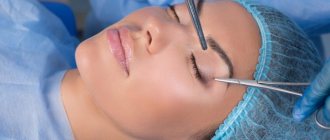Blepharoplasty: what is this procedure and why is it becoming popular among residents of Komi
Affiliate material. Until a certain time, you can maintain youth and beauty with the help of cosmetics. But there will definitely come a time when a person is faced with a choice - to come to terms with age-related changes in the area around the eyes and his reflection in the mirror, or to decide on blepharoplasty.
The portal spoke with Dmitry Kovalenko, a doctor at plastic surgery of the face and body at the Family Clinic in Kirov, about how blepharoplasty is performed and what prejudices about surgery it is time to abandon.
Dmitry Kovalenko
Blepharoplasty: what is it and how does it happen?
Blepharoplasty is a plastic surgery during which a plastic surgeon removes excess skin, fatty hernias, and “bags” in the upper or lower eyelids. Also, if necessary and desired by the patient, modern techniques make it possible to change the shape and shape of the eyes, eliminate congenital and acquired defects as a result of injuries or surgical interventions. As a result, your eyes become clear and open, your face looks younger and more attractive, and you gain a refreshed appearance.
The work of Dmitry Kovalenko: before and after blepharoplasty
Blepharoplasty can be performed under either general anesthesia or local anesthesia.
— Blepharoplasty of the upper eyelids lasts about 40–60 minutes, blepharoplasty of the lower eyelids — 60–80 minutes. If plastic surgery of the upper and lower eyelids is performed simultaneously, the duration of the operation is about 2 hours. For upper eyelid surgery, the incision is made in the natural crease of the eyelid; for lower eyelid surgery, the incision is made 1.5 mm below the eyelash line and through the mucous membrane of the eyelid (transconjunctival). Also, if you wish, you can do circular blepharoplasty - this is an operation to remove excess skin on the upper and lower eyelids at the same time,” said Dmitry Kovalenko.
The work of Dmitry Kovalenko: before and after blepharoplasty
Why is blepharoplasty so popular?
Plastic surgery in Russia in general is becoming more and more popular. According to the analytical center of the specialized magazine Vademecum, Russia is among the top 15 countries in the world in terms of the number of aesthetic operations. And the most popular plastic surgery in Russia in 2022 turned out to be blepharoplasty - the News.ru portal wrote about this with reference to the press service of the chief freelance specialist of the Ministry of Health and plastic surgeon Natalya Manturova.
— Today, plastic surgery has become much more accessible than a few years ago. Previously, you had to go to Moscow for such operations, and only wealthy people could afford them. But everything has changed for the better. You don’t need to travel far: the “Family Clinic” is only 5 hours away by car from Syktyvkar, and for residents of Komi, blepharoplasty including hospital stay, anesthesia and surgery costs from 34 thousand rubles.
Laser non-surgical eyelid blepharoplasty
The skin around the eyes is the most vulnerable place on the face. Wrinkles are noticeable on it due to the thin layer of dermis. In addition, it contains a small amount of collagen, so it needs especially careful care.
Non-surgical blepharoplasty is a unique technique that rejuvenates the skin of the upper and lower eyelids. The non-surgical procedure is an alternative to plastic surgery that is just as effective. The main advantage of the method is safety for the body and rapid rehabilitation.
The decision to perform the procedure is made by the doctor after examining the patient and reviewing the patient’s medical history.
At Sapphire, non-surgical blepharoplasty is performed using a Kristall diode laser. This laser belongs to a new generation of medical devices and has a registration certificate from Roszdravnadzor, which indicates its safety and effectiveness.
The uniqueness of the procedure is that the doctor, using a specialized attachment and a flexible light guide, easily performs a targeted effect on certain areas of the eyelids, creating microscopic fractions of thermolysis, which leads to a narrowing of the areas of influence during the rehabilitation process, and as a result, a natural tightening of the eyelid occurs. Laser exposure also helps to activate the production of collagen and elastane. Thanks to these substances, folds are smoothed almost naturally.
When is the procedure indicated?
Non-surgical eyelid blepharoplasty is prescribed in the following cases:
- when the skin of the eyelid hangs over the eyelashes;
- if you have bags under the eyes;
- with thinning of the epithelium in the periorbital region;
- during the formation of the nasolacrimal groove.
Advantages of non-surgical treatment
Non-surgical facial blepharoplasty is considered a quick and safe method of epithelial rejuvenation. The procedure also has a number of additional advantages:
There is no need for a long recovery period. After performing the manipulations, patients are immediately sent home. The duration of the rehabilitation period ranges from 2 to 10 hours. It is allowed to engage in work activities immediately after exposure. After 3-4 days, traces of the surgical impact disappear.
No need for anesthesia. This allows patients of different ages to resort to the procedure, being completely confident in its safety.
No traces after the operation. After blepharoplasty, there will be no visible or hidden incisions on the face.
The use of atraumatic methods of exposure allows you to be sure that there is no possibility of bleeding or infection of the body.
Leveling out coagulation and blockage of blood vessels, which minimizes the risk of blood loss and guarantees a lasting lifting effect.
Simple rehabilitation period. It has been confirmed that after non-surgical blepharoplasty, swelling and cyanosis disappear much faster.
Most often, women turn to the procedure after 40 years. They want to tighten the skin in the eyelid area, restore its former elasticity and beauty. The number of procedures is selected individually, depending on the condition of the eyelids and the desired result. It may require only 1 procedure, but it can also be a course (up to 3 procedures) with an interval of a month.
After blepharoplasty of the lower and upper eyelids, the skin tightens, brightens, its upper layer is leveled, and wrinkles are smoothed out.
Eyelid surgery
Cosmetic blepharoplasty (eyelid surgery) is a complex of surgical procedures to eliminate age-related eyelids and the adjacent (periorbital) area, including skin, fatty tissue and orbicularis muscle plastic surgery.
The operation is purely individual, the scope of the intervention is determined through a thorough preoperative examination of the patient in person and from photographs, identifying existing facial asymmetries and taking into account the wishes and expectations of the patient, so that the appearance after surgical treatment remains as harmonious as possible.
A standard skin incision of the upper eyelid is made along the skin fold at a distance of 7-9 mm from the ciliary edge of the eyelid; lower eyelid - retreating 2-3 mm from the ciliary edge. Often the incision is extended by 1-2 cm into the skin of the temple.
In the absence of keloid scarring, over time, postoperative scars become barely noticeable or not noticeable at all, as they are located along the natural folds of the skin. On average, at least 10-12 weeks should pass before they are completely smoothed out and the color “evens out” with the shade of the surrounding skin. Scars heal in several stages. In the first 4 weeks, postoperative scars go through a granulation phase, when new connective tissue rich in small vessels forms at the incision site. As a result, by the end of the first month, the incision site turns into a pink scar. In the next 1-1.5 months, the scar is organized and turns into a white thin line that almost does not protrude above the surface of the skin.
Blepharoplasty price
| Name | Cost, rub. |
| Blepharorrhaphy | 11 300 |
| Blepharoplasty lower eyelid | 24 600 |
| Blepharoplasty upper eyelid | 24 600 |
| Blepharoplasty for traumatic coloboma | 27 000 |
Types of blepharoplasty:
There are the following types of blepharoplasty, depending on the topography:
- plastic surgery of the upper eyelids (blepharochalasis);
- plastic surgery of the lower eyelids, circular blepharoplasty (used extremely rarely);
- transconjunctival (the incision goes through the lower fornix; the operation is performed in young patients in the absence of excess skin).
Preparing for surgery
The indication for blepharoplasty is the patient’s desire to get rid of cosmetic and aesthetic defects of the upper third of the face: bags and swelling under the eyes, some types of wrinkles, as well as to cope with such an unpleasant disease as ptosis (drooping of the upper eyelids). With the help of blepharoplasty, it is possible to slightly lift the outer corners of the eyes, eliminate asymmetry, and remove excess skin on the lower and upper eyelids.
Preoperative preparation requires a responsible approach on the part of the patient. Initially, you will need to undergo a medical examination to identify possible contraindications. Also, 2 weeks before blepharoplasty, it is necessary to avoid the use of alcohol and a number of drugs that affect blood clotting, stop smoking and tanning. A week before surgery, hemostatic drugs are prescribed.
The choice of anesthesia is determined by the anesthesiologist. Local infiltration anesthesia is often used in combination with intravenous sedation. In rare cases, general anesthesia is used (according to individual indications).
Contraindications:
Contraindications to blepharoplasty are:
- diabetes mellitus (decompensated);
- thyroid diseases;
- cardiovascular diseases (including hypertension);
- diseases of the kidneys, liver, respiratory tract;
- skin defects of the paraorbital area of a post-traumatic nature;
- diseases of the central nervous system;
- infectious diseases in the acute stage.
Local contraindications include:
- chronic diseases of the eyelids and conjunctiva;
- dry eye syndrome;
- increased intraocular pressure (glaucoma);
- high myopia.
Surgery and rehabilitation period
The duration of the operation depends on the volume of intervention, the condition of the skin, subcutaneous fat, muscle tissue, and the patient’s blood coagulation system. The average duration of the operation is 40-60 minutes for each eyelid.
As a rule, the operation is well tolerated. However, any surgical operations cause disruption of microcirculation and lymphatic drainage in the intervention area. In the early postoperative period, the main consequences are swelling of the soft tissues of the eyelids, hemorrhages, and decreased skin sensitivity. Using cold compresses and pressure bandages for 1-2 days after surgery will help prevent the formation of hematomas and speed up their resorption.
The average duration of the effect is 5-7 years, but largely depends on the general state of health, individual characteristics, lifestyle, and hygienic eyelid skin care.
Despite its apparent simplicity and safety, blepharoplasty is a serious surgical procedure with all its risks and possible consequences. According to the literature, even successfully performed plastic surgery (from the point of view of postoperative complications) does not always guarantee a satisfactory aesthetic effect. Blepharoplasty may have consequences specific only to this type of intervention, namely:
- change in the shape of the eyes (lowering or raising the outer corners, rounding of the eyes, asymmetry);
- inversion of the lower eyelid;
- “excessive” removal of eyelid skin causes difficulty closing the eyes;
- change in facial expressions.
In our practice, the percentage of the above complications is extremely small, due to the careful individual approach and preoperative examination of each patient, and the use of high-tech microsurgical surgical techniques.
The rehabilitation period after blepharoplasty is 10-12 days. It is recommended not to wear contact lenses for the first 2 weeks after surgery. You can apply makeup no earlier than ten days later. To shorten the recovery time after blepharoplasty, special physiotherapy procedures are prescribed.
In the postoperative period, you should refrain from prolonged exposure to direct sunlight and use sunglasses in the first 8-10 weeks after eyelid surgery. You should also avoid visiting the solarium during this period. It is recommended to avoid staying in baths and saunas. Excessive exposure to solar ultraviolet radiation and high temperatures can affect the color of the scar and cause excessive growth of connective tissue, which leads to an increase in the size of the scar and increased compaction. These changes may result in a scar or keloid.
Blepharoplasty is an intervention on the adnexa of the eye without affecting the eyeball itself. There were no cases of decreased vision in the postoperative period in our practice.
EXAMPLES OF BLEPHAROPLASTY WORK
YOUR DOCTORS:
Matrosova Yulia Vladimirovna
Ivolgina Irina Valentinovna
You can make an appointment in advance and get additional information by calling the helpline:
8; 8 calls within Russia are free.
Every day from 8:30 to 17:00 (Mon. - Thurs.), from 8:30 to 16:00 (Fri.).
Make an appointment
Blepharoplasty
Types of blepharoplasty.
In our clinic in Kaluga, blepharoplasty is performed using advanced techniques and does not leave any signs of intervention after the rehabilitation period. We carry out all types of this procedure:
- Correction of the upper eyelids - through an incision in the crease of the eyelid, excess skin and fatty tissue are eliminated, due to which the “overhanging effect” is formed.
- Correction of the lower eyelids - the incision is made just below the eyelash growth line, measuring no more than 1.5-2 mm; through it, excess skin and fatty hernias are removed.
- Circular or classic - combines the two methods described above and allows you to eliminate problems of the upper and lower eyelids simultaneously.
We also perform transconjunctival blepharoplasty - a method of removing fatty hernias in the lower eyelid, through an incision in the conjunctiva. In this case, stitches are not applied, but the shell sticks together and grows together within a few days.
Blepharoplasty is often performed in combination with other procedures—facelift, forehead lift, and others.
Features and advantages of the procedure in our clinic.
The types and methods of surgery are selected individually, depending on the existing problems and structural features of the eyelids. To do this, a thorough examination of the patient and analysis of complaints about the condition of the skin of the eyelids are carried out.
If the operation is performed correctly, there are no risks or complications. The safest and most effective blepharoplasty in Kaluga is performed in our clinic. This is evidenced by many successful operations and excellent results in patients.
We help eliminate any complications:
- high professionalism of doctors;
- modern, innovative methods of performing the procedure;
- availability of the best equipment;
- absolute sterility of premises and instruments;
- individual approach to each patient.
When performing the operation, we make minimal incisions that are completely invisible after complete healing.
Rehabilitation after surgery.
During the rehabilitation period, you should strictly follow the doctor's recommendations. At this time it is necessary:
- avoid direct sunlight and reading;
- give up decorative cosmetics;
- refrain from wearing contact lenses;
- reduce physical activity.
The duration of recovery depends on the individual characteristics and type of surgery performed, its complexity - from one to three weeks. In most cases, you can return to your normal lifestyle within 2-3 weeks.
Contraindications.
Blepharoplasty has the following contraindications:
- chronic diseases in the acute stage;
- diabetes;
- oncological, infectious diseases;
- endocrine disorders;
- intraocular pressure and eye pathologies.
Before performing the operation, the patient undergoes consultations with specialists, undergoes the necessary tests, and only if there are no contraindications, our doctors perform the procedure.
You can sign up for blepharoplasty in Kaluga, as well as find out the details of its implementation, by calling the clinic numbers.









